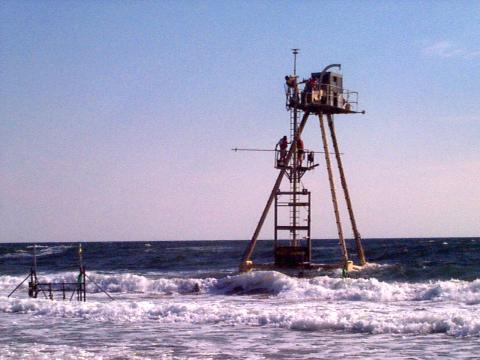The unique three-wheeled Coastal Research Amphibious Buggy, the CRAB was built by the Wilmington District of the US Army Corps of Engineers, and was modeled after a vehicle originally built by Marine Travelift & Engineering of Sturgeon Bay, for the Great Lakes Dredge and Dock Company, to monitor a Corps of Engineers beach nourishment project.
The (CRAB) consists of a tripod of 0.2 m schedule-80 aluminum tubing, connected at the base by horizontal members 2.1 m (7 ft) above the ground, and an operations platform 10.7 m (35 ft) above the ground. Power is supplied by a 53-hp Volkswagen engine on the deck which drives a variable stroke hydraulic pump. This pump transfers hydraulic fluid at 800 psi or higher to hydraulic motors at each of the wheels. The variable stroke feature of the pump allows an infinitely variable gear ratio in either forward or reverse and constant engine speed. For strength and corrosion resistance, all hydraulic lines are stainless steel, except for short flexible sections at the front wheel, which is used for steering.
Total vehicle weight is about 8,200 kg (18,000 lb); the distance between the rear wheels is 8.2 m (27 ft). Though it appears top-heavy, the liquid-filled tires and wide wheelbase make it very stable. The CRAB has passed a 20-deg tilt test and is designed to withstand even steeper angles.
Top speed of the CRAB is 3.2 km/hr (2 mph) on land and somewhat less in the water. Since the maximum significant wave height for operation is 2 m (6 ft), the CRAB is capable of operating in all but the most severe storms. The large tires have a negligible effect on a hard rippled sand bottom; however, scour around the tires has been observed in areas of active wave breaking or strong currents if the CRAB remains motionless. The CRAB cannot be used on soft silty or loose bottoms. The position of the CRAB is determined by using an array of prisms, which serves as a target for the Zeiss Elta-2s Electronic Survey System and the Geodimeter 140T Auto-Tracking Survey System.
Taken from the US Army Corp of Engineers Field Research Facility, Coastal & Hydraulics Laboratory (http://www.frf.usace.army.mil/aboutUS/equipment.shtml).
